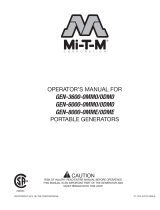
2 BRIGGSandSTRATTON.COM
Equipment Description
Table of Contents
Equipment Description.........................2
Features and Controls .........................5
Operation....................................7
Maintenance ................................14
Storage ....................................17
IC Information to User ........................17
Troubleshooting/Specifications .................18
Warranty ...................................20
Register Your Product
To ensure prompt and complete warranty coverage, register
your product online at www.onlineproductregistration.com.
Symbols and Meanings
Signal Meaning
DANGER
Indicates a hazard which, if not avoided, will
result in death or serious injury.
WARNING
Indicates a hazard which, if not avoided, could
result in death or serious injury.
CAUTION
Indicates a hazard which, if not avoided, could
result in minor or moderate injury.
NOTICE
Indicates information considered important, but
not hazard-related.
Symbol Name Explanation
Safety Alert
Symbol
Indicates a potential personal injury
hazard.
Operator’s
Manual
Failure to follow warnings, instructions
and operator’s manual could result in
death or serious injury.
Toxic Fumes
Engine exhaust contains carbon
monoxide, a poisonous gas that
will kill you in minutes. You cannot
smell it or see it.
Fire
Fuel and its vapors are extremely
flammable which could cause
burns or fire resulting in death or
serious injury.
Engine exhaust could cause fire
resulting in death or serious injury.
Electric
Shock
Generator could cause electrical
shock resulting in death or serious
injury.
Hot Surface
Muffler could cause burns or
resulting in serious injury.
WARNING! This product can expose you to
chemicals including gasoline engine exhaust, which
is known to the State of California to cause cancer,
and carbon monoxide, which is known to the State of
California to cause birth defects or other reproductive harm.
For more information go to www.P65Warnings.ca.gov.
Equipment Description
Read this manual carefully and become familiar
with your outdoor generator. Know its applications,
its limitations, and any hazards involved. Save
these original instructions for future reference.
The outdoor generator is an engine–driven, revolving
field, alternating and direct current (AC & DC) generator.
It was designed to supply electrical power for operating
compatible electrical lighting, appliances, tools and motor
loads. The generator’s revolving field is driven by a single-
cylinder engine.
To move generator, press button and pull handle out.
Press button to push handle back in.
The portable generator can be used to power outdoor items
using extension cords or for providing power to your travel trailer/
recreational vehicle (RV). DO NOT connect generator to a home’s
electrical system.
The generator is not intended to supply systems that are
legally required, for serious life safety or health hazards,
or where lack of power hampers rescue of fire-fighting
operations.
Every effort has been made to ensure that the information in this
manual is both accurate and current. However, the manufacturer
reserves the right to change, alter or otherwise improve the
generator and this documentation at any time without prior notice.
NOTICE If you have questions about intended use, contact an
authorized service dealer. This equipment is designed to be used
with Briggs & Stratton® authorized parts only.
System Ground
The generator neutral is floating, which means that the
neutral wire is isolated from the grounding fastener and the
AC receptacle ground pins. On a floating neutral generator
the AC receptacle ground pins are not functional. Electrical
devices, such as a GFCI, requiring a functioning AC
receptacle ground pin will not operate.
Special Requirements
There may be federal or state regulations, local codes, or
ordinances that apply to the intended use of the generator.
Please consult a qualified electrician, electrical inspector,
or the local agency having jurisdiction.
This generator is not intended to be used at a construction
site or similar activity as defined by NFPA 70-2017 (NEC)
section 590.6.




















